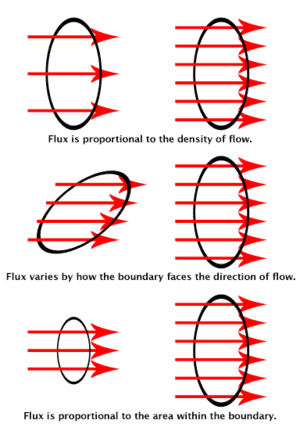Flux facts for kids
Flux is a word used in physics and mathematics. It basically means "how much of something passes through a certain area." Think of it like a "flow."
For example, imagine you are holding a butterfly net. The amount of air that moves through the opening of your net is a type of flux. It's about how much "stuff" (like air) is flowing through a specific space (the net's opening).
What is Flux?
Flux helps us understand how different things move. It measures the flow of something through a specific area over time. For instance, it could be how much heat moves through a window. Or how many molecules of a gas spread out in a room.
Flux is often described as a vector. This means it has both a size (how much is flowing) and a direction (where it is flowing).
There are many types of flux. Each one helps scientists study different kinds of movement. Here are some common examples:
- Heat flux: This is how much heat energy moves through an area. Imagine the heat from a stove moving into a pan.
- Chemical flux: This measures how many molecules of a substance move through an area. This is important in things like how smells spread.
- Mass flux: This is about how much mass (like water) flows through an area. Think of water flowing in a pipe.
- Radiative flux: This measures the energy from light or other radiation moving through an area. Astronomers use this to study stars.
- Magnetic flux: This describes the strength of a magnetic field passing through an area. It's important for understanding magnets and electricity.
Flux in Electricity and Magnetism
In electromagnetism, flux helps us understand electric fields and magnetic fields. Here, flux is often about how much of a field passes through a surface.
For example, magnetic flux tells us how many magnetic field lines pass through a certain area. This is important for how electric generators and motors work.
Electric flux is similar. It measures how much of an electric field passes through a surface. This helps us understand how electric charges create fields.
Sometimes, you might hear about "power flux." This is the rate at which electromagnetic energy flows through a surface. It's measured in watts per square metre (W/m2).
Related topics
- Fluid dynamics
- Heat transfer
- Mass transfer
See also
 In Spanish: Flujo para niños
In Spanish: Flujo para niños


